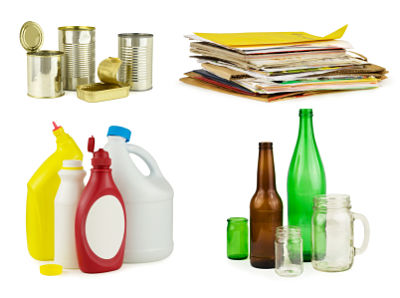After your recyclables are sorted, baled, and shipped to market, they go through a process to be turned into new things we use. “How do they do that!?” you might ask yourself. Each material is processed in a different way. See the list of materials below to find out how.
Aluminum

Aluminum you can recycle at home: Beverage cans, clean foil and clean food trays
Do not put these aluminum items in your recycling cart: Scrap metal, soiled foil or soiled food trays
How do they do that?
Aluminum shipped to the smelter first has to be shredded or ground into pieces that resemble potato chips. The “potato chips” are then melted into ingots (bar or block of metal). The aluminum ingots are sent to the manufacturer (product maker) where they are pressed into sheets and cut. Aluminum sheets can be made into all sorts of new items.
Some items made with recycled aluminum: Cans, car parts, foil, house siding, lawn chairs, pie pans, and window frames
Energy savings: 92%
Glass

Glass you can recycle at home: Jars and bottles of any color
Do not put these glass items in your recycling cart: Ceramics, mirrors, window glass
How do they do that?
Mixed glass containers are crushed into tiny pieces called cullet. Glass recyclers then use equipment to remove non-glass residue such as labels and lids. The cullet is sometimes used as an aggregate for construction projects. Other times the cullet is blended with different types of sedimentary rock and melted. The liquid mixture is poured into molds to create new products. Glass can be recycled endlessly.
Some items made with recycled glass: Aggregate for roads and sidewalks, bottles, countertops, fiberglass, household decor, insulation, jars, jewelry, marbles, and tiles
Energy savings: 34%
Paper

Paper you can recycle at home: Catalogs, cardboard, junk mail, milk and juice cartons, newspapers, magazines, office paper, paperback books, paperboard (such as cereal boxes), phone books, wrapping paper
Do not put these paper items in your recycling cart: Hardback books, napkins, paper towels, tissues, toilet paper
How do they do that?
At a paper mill, paper is shredded in a huge pulper and turned into individual cellulose fibers. The water and fiber mixture is called slurry (think of it as a paper milkshake). The slurry is cleaned, screened and washed to remove contaminants (foreign material such as staples, rubber bands and ink). Next, the slurry is pressed on screens to push the fibers back together, then dried on large, heated rollers. Rolls of paper are sent to printers, offices and packaging manufacturers. A similar process is used to recycle cardboard and paperboard.
Some items made with recycled fiber: Animal bedding, cardboard boxes, coloring books, egg cartons, game boards, new paper, newspaper, packaging, paper towels, puzzles, tissues, telephone books, and toilet paper
Energy savings: 68%
Plastic

Plastic you can recycle at home: Buckets (up to 5 gallons), beverage containers, dish soap and laundry soap bottles, food containers, milk and juice jugs, shampoo and similar health and beauty containers, tubs (such as cottage cheese, margarine and yogurt tubs)
Do not put these plastic items in your recycling cart: Plastic bags of any kind, #6 plastics (such as Styrofoam)
How do they do that?
Plastic is shredded into small flakes. Contaminants such as labels and lids are removed in flotation tanks. The plastic flakes are washed, heated and melted. The liquid plastic is forced through an extruder. An extruder is a mechanical device used to form material. After the liquid is passed through the extruder, long strands are created and cooled. The plastic strands might be cut into pellets. The strands might also be crimped into thread that can be woven into material.
Some items made with recycled plastic: Benches, bottles, carpet, fleece, flower pots, furniture, playground equipment, recycling carts, rulers, shoelaces, sleeping bags, t-shirts, vehicle parts, waste cans, and other miscellaneous plastic products
Energy savings: 87%
Steel

Steel you can recycle at home: Cans
Do not put these steel items in your recycling cart: Scrap metal
How do they do that?
Steel is sold to a steel mill. Food cans made with steel have a thin tin coating to preserve the food. The first step in the recycling process is to remove this coating. The coating is removed with by dipping the cans into a chemical solution. Once the tin coating is gone, the steel cans are rinsed and flattened into bales. A bale is a large, compact bundle of goods. Finally, the bales of steel are melted down to liquid metallic iron to be used in new steel production. Steel can be recycled endlessly. In fact, all steel products contain at least 25% recycled material.
Some items made with recycled steel: Appliances, cans, containers, fire hydrants, furniture, tools, toys, and vehicle parts
Energy savings: 56%
Source: Institute of Scrap Recycling Industries, Inc., 2009



